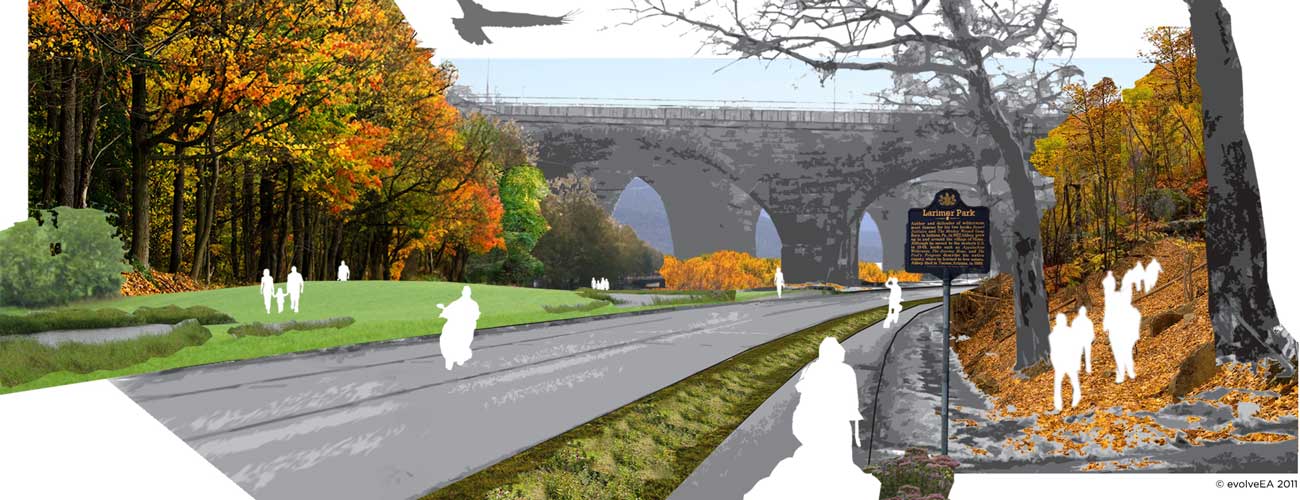Ecodistricts 101
What is an Ecodistrict?

An ecodistrict is a community that is embedded in a holistic model of sustainable planning at the neighborhood scale that empowers people to take ownership over their individual and collective futures.
evolveEA’s Creating A Living City project in Larimer outlined the main differences between conventional urban planning and ecodistrict planning as follows. While traditional development focuses on developing the built environment, ecodistrict planning focuses on developing both the hardware AND software of a community. Within this framework, physical space and the built environment (hardware) is developed in harmony with a community’s social and cultural networks (software) where people work together to improve quality of life through engagement, stewardship, and community leadership.
Ecodistricts foster a cooperative, integrated, neighbor-to-neighbor approach to building community. Sustainable development practices are utilized to build on a community’s strengths, identify ways to bring opportunity for growth into the neighborhood, and prioritize equity, resiliency, and climate protection in the planning process.
The goal of creating an ecodistrict is to grow positive and thriving places where all people can live, work, and play. This process can eventually lead to certification for your community if all requirements are fulfilled.
What are sustainable development practices?

Sustainable development practices are those that meet the needs of the present without compromising quality of life for future generations. These practices take into consideration how development impacts our economy, attempt to preserve the natural resources and beauty of our surrounding landscapes, and provide voice to the people who reside in the community.
Sustainable development brings together neighbors, community institutions, businesses, city leaders, and utility providers as a team to make a place where everyone is supported and involved.
Why start an Ecodistrict?

In the past 40 years, cities and small towns alike have experienced changes in their local economies due to a number of factors, including suburban growth, population changes, relocation of industry, and localized hyper-investment. Often, these changes result in shrunken local economies and lack of resources. Small towns have started to diversify their economies by finding unique ways to attract new industries and to draw in new residents. We need to bring good jobs, families, local business, and stewardship of natural spaces back to our small towns.
The ecodistrict planning process joins resident-driven leadership with professional community designers to work as a team to create a pathway towards development that reflects community needs. Results include retaining current community while also attracting growth, growing community pride, improving environmental health, and instilling protections against gentrification.
Using this model of development will help ensure that your community plan is thoughtful and smart yet creative and bold. and will make sure we are united in our priorities towards creating safe and healthy places to live that will last for future generations.
EcoDistricts vs. Ecodistrict vs. ecodistrict
You might see varying forms of capitalization when exploring the idea of an ecodistrict in your community. This is intentional, and they each have their own meaning:
- “ecodistrict” refers to the concept in the field of urban planning that integrates ecologically-sound practices with sustainable community development.
- “Ecodistrict” refers to a specific community that is engaged developing an ecodistrict.
- “EcoDistricts” refers to the parent organization that formulated and published the official Protocol and oversees a certification process. They are a 501(c)(3) nonprofit organization based in Portland, Oregon.
Elements of an Ecodistrict
The substance of your particular ecodistrict plan can be broken down into various focus areas that match your community’s particular needs.The focus areas of your plan should ultimately address improving quality of life in your community. They can be decided on at a community meeting, after collecting data about what community members most value, in collaboration with community members and professionals during the initial planning phase. They serve as concepts that will be further broken down into more specific goals, targets, and actions.
For example, the Millvale, Etna, and Sharpsburg Ecodistricts have adopted six quality of life issues as a regional framework across the Triboro region: food, water, energy, air quality, mobility, and social equity. These quality of life issue categories highlight the three Borough’s most central needs to focus on in their ecodistrict planning processes.

EQUITY – access to education, affordable housing, employment opportunities, health & wellness, and fairness in development

FOOD – increasing access to a grocery store, providing support for self-growing food, access to kitchens for food preparation, and improving food education

WATER – cleaner water, mitigating flooding issues, increasing recreational space, and riverfront connectivity

ENERGY – reducing energy cost burden, adding resilience to the system, and equitable access to energy efficient and/or renewable energy options

AIR QUALITY – reducing the impacts of industrial smog, addressing health conditions like asthma, and increasing

MOBILITY – improved access to jobs and amenities, increasing public safety, greater walkability, and freedom of movement for all transportation methods
Guiding Principles
When embarking on your ecodistrict journey, it is important to keep in mind a few guiding principles to ensure the most successful and vibrant outcome in your community. These are based on lessons learned building successful ecodistricts since 2012, including key components of New Sun Rising’s Vibrant Communities Framework and the expertise of evolveEA.
- Lead with Equity, Education, and Capacity Building. Equity is just as important in the process of implementing an ecodistrict as it is in the plan itself. Understanding that all voices need to be heard in the planning process is critical to a successful outcome where everyone benefits. Likewise, community education is the first step to empowerment. It will be difficult to take appropriate actions without a community that is fully informed on the process and how each focus area impacts them.
- Invest in Resident leadership. Residents know their community better than anyone else. Their input is crucial for a development outcome that is equitable, as only they are able to fully understand what is needed in their community to improve quality of life and provide opportunities for everyone to reach their greatest potential.
- Connect with Local, Regional, and National Experts. Communities of all sizes, populations, and budgets have successfully implemented ecodistrict planning and are able to share their experiences and expertise to guide your own planning and implementation. Take some time to visit local ecodistrict happenings in close to your community. Connecting with those currently engaged in the process, and learning more about emerging best practices for community development, will better inform your community’s efforts.
- Take Action! People are inspired to contribute to the growth of ecodistricts when they see conversations happening, people getting involved, and improvements being made to their community in real-time. The power of action, even from just one person to start, will help build a base of support that will be critical for implementation and achieving successful results.
EcoDistricts Protocol
The official EcoDistricts Protocol, formulated by the Portland, Oregon based nonprofit, requires participating communities to incorporate three main imperatives in their planning and development: Equity, Resiliency, and Climate Protection. Under this overarching umbrella, communities must address six priority areas: Place, Prosperity, Health & Wellbeing, Connectivity, Living Infrastructure, and Resource Restoration. The EcoDistricts Protocol is designed for flexibility and adaptability based on your own community’s need.
Within the overarching Ecodistrict Protocol lies three main stages in the implementation of an Ecodistrict that each community must work through to achieve certification: Formation, Roadmap, and Performance.
- The Formation Phase is where you will do your initial organizational planning and make a commitment to each of EcoDistricts Protocol Imperatives.
- The Roadmap Phase is where your community will develop a plan or “Roadmap” that outlines key goals and projects, programs, and metrics to achieve these goals.
- The Performance Phase is where you will implement your Ecodistrict plan and biannually report on progress made using your chosen indicators and metrics.
NOTE: This content, including photographs and text, has been prepared by New Sun Rising and adopted for publication on evolveEA.com.


